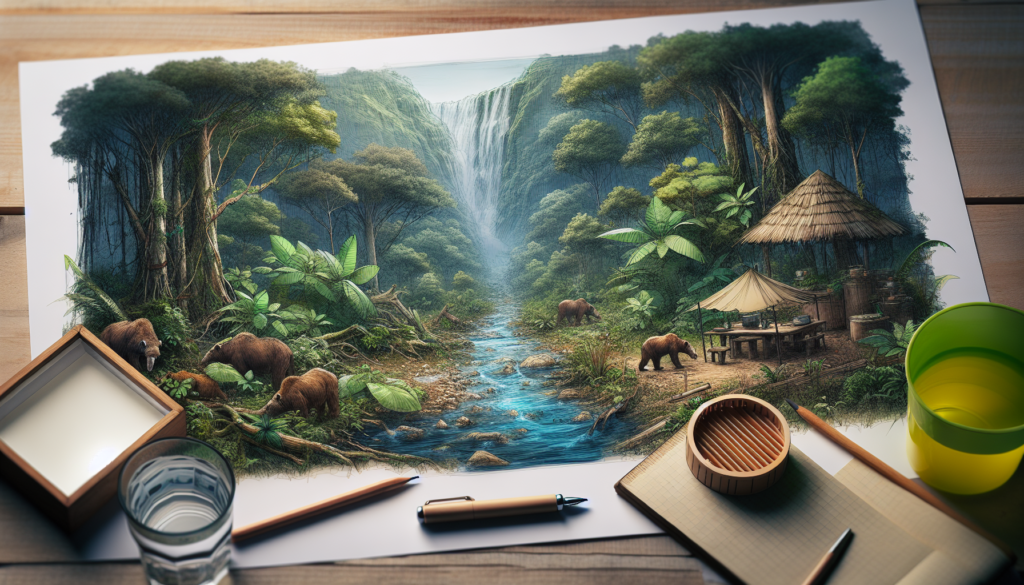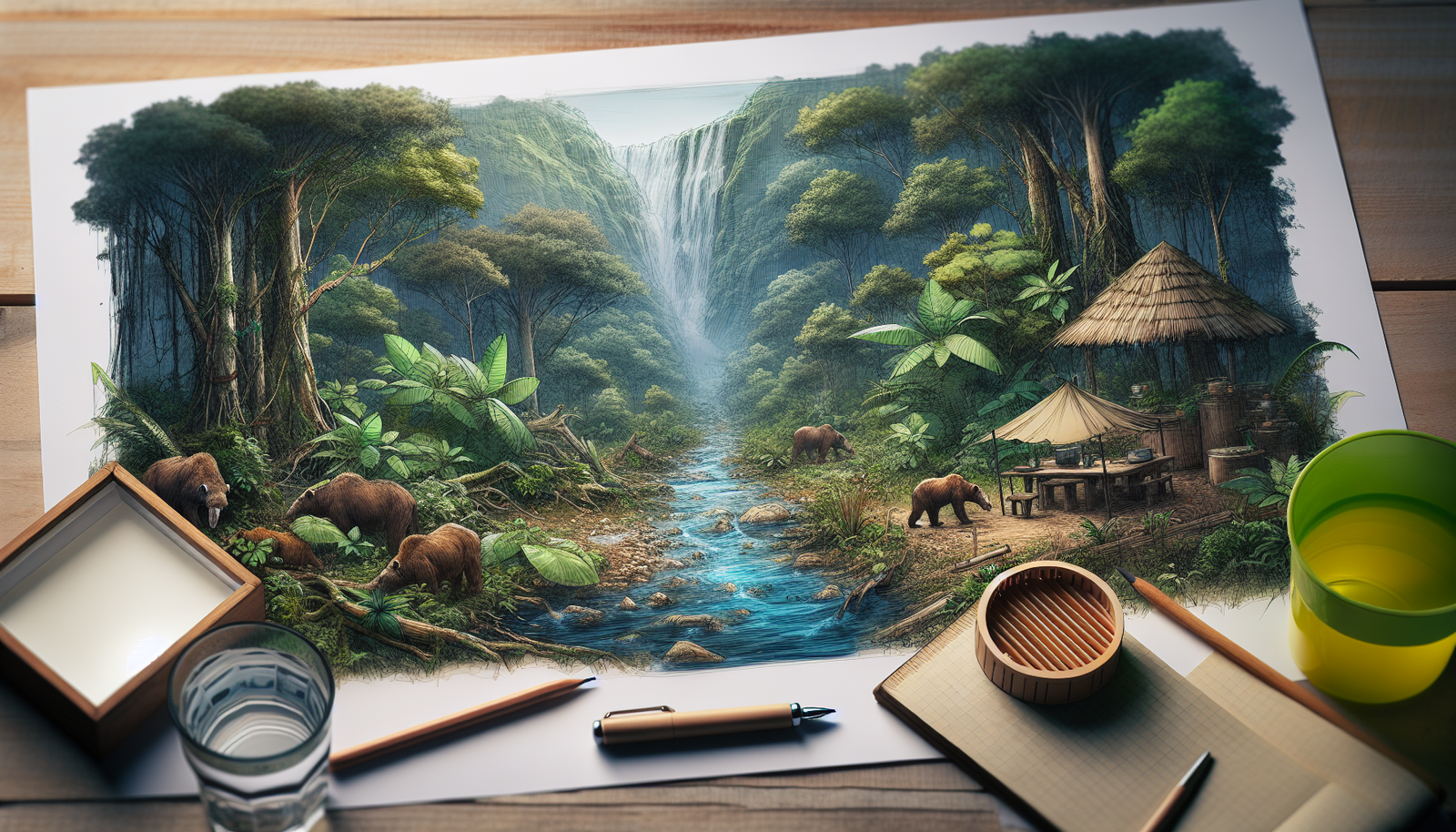Imagine yourself in the vast wilderness, surrounded by towering trees and untouched landscapes. As you embark on your adventurous journey, a crucial element for survival becomes apparent: water. In this article, we will guide you through the art of finding and purifying water in the wilderness. From identifying natural sources to employing effective purification methods, we’ve got you covered. So, join us as we equip you with the skills and knowledge needed to quench your thirst in even the most remote corners of the great outdoors.

Methods for Finding Water in the Wilderness
Knowledge of the Terrain
When you find yourself in a wilderness situation, having knowledge of the terrain can significantly aid in locating water sources. Understanding the topography, such as valleys, ridges, and depressions, can give you an idea of where water might accumulate. Additionally, studying maps and having familiarity with the surrounding area can help you identify potential water sources, such as rivers, lakes, or springs, which may not be immediately visible.
Following Animal Trails
Animals are experts at finding water in the wilderness, so why not take advantage of their instincts? Look for game trails or tracks that indicate animal movement and follow those paths. Animals rely on water sources for survival, so it is highly likely that their trails will lead you to a water body, such as a creek or a watering hole. Be cautious and observe your surroundings, as the presence of wildlife can also indicate the availability of water nearby.
Listening for Sound
Water often makes a distinct sound, even from a distance. In a serene wilderness environment, you can sometimes hear the sound of running water, such as a babbling brook or the rush of a waterfall. Take a moment to be still and listen attentively for any signs of water nearby. Follow the direction of the sound, and it may guide you to a reliable water source.
Observing Vegetation
Vegetation, particularly green and dense growth, can be indicative of water sources in arid or desert environments. Look for vibrant plant life, such as willows, cottonwoods, or other species that require ample water to thrive. These plants often grow near water bodies, revealing the presence of rivers, streams, or ponds. Additionally, keeping an eye out for damp or muddy areas can also give you clues about potential water sources.
Examining the Ground
Carefully inspecting the ground can provide essential information about water sources. Look for damp or moist areas, which may indicate the presence of underground water or nearby springs. Alternatively, if you notice depressions or low-lying areas that collect water during rainfall, these might serve as potential water catchments. Pay attention to signs of animal activity or tracks in the area, as these could lead you to water sources as well.
Digging for Water
In some situations, water may not be immediately visible on the surface, requiring you to dig for it. Once you have located a potential water source, such as a dry riverbed or a muddy area, dig a hole several feet deep. Wait for some time; if the hole fills up with water, you have successfully found a water source. Remember to use a container or cloth to filter out any sediment or debris before consuming the water.
Using Solar Still
A solar still is a simple but effective way of extracting water from moist soil or vegetation. To create a solar still, dig a hole in the ground and place a container or plastic bag in the center. Surround the hole with green vegetation or moist soil and cover the entire setup with a clear sheet of plastic. As the sun heats the area, moisture will evaporate and condense on the plastic, eventually collecting in the container. This method can help you obtain drinkable water in arid environments.
Rainwater Collection
Rainwater is a valuable and readily available source of water in the wilderness. When rain showers occur, try to collect the water using whatever containers you have on hand, such as bottles or tarps. Set up a catchment system by suspending the container below a tree branch or using a tarp to channel water into a collection point. You can also construct a simple rainwater barrel to store larger quantities of water. Remember to filter and purify the collected rainwater before drinking it.
Water Sources to Avoid
While it is crucial to find water in a wilderness situation, not all water sources are safe for consumption. Avoid drinking water from stagnant ponds, swamps, or streams with foul smells or unusual colors, as these can indicate contamination. Similarly, water sources near industrial areas, livestock operations, or human settlements may pose a higher risk of contamination. Always prioritize finding and treating water from natural sources, such as springs or deep wells, to ensure your safety.
Navigation Techniques
Navigation techniques can assist you in locating water in the wilderness. Using a compass or GPS device, you can determine your direction and plan your route towards potential water sources. Additionally, studying maps and understanding the layout of the land will assist you in finding water bodies. Learning basic navigation skills and having the necessary tools in your wilderness survival kit can greatly enhance your chances of locating water when needed.
Techniques for Purifying Water in the Wilderness
Boiling Water
One of the simplest and oldest methods for purifying water is boiling. Boil water for at least one minute to kill most bacteria, viruses, and parasites that may be present. If at higher altitudes, it is advisable to boil water for longer due to the lower boiling point. Remember to let the water cool before consuming it to avoid burns.
Using Water Treatment Tablets
Water treatment tablets, such as chlorine or iodine tablets, can be an effective way to purify water in the wilderness. Follow the instructions on the packaging, which usually involves adding the tablet(s) to a specific volume of water and waiting for the recommended contact time. These tablets work by releasing chemicals that kill or neutralize pathogens, making the water safe to drink.
Chemical Purification
Chemical purification involves using chemical agents, such as chlorine, iodine, or hydrogen peroxide, to treat and disinfect water. These chemicals effectively kill microorganisms, making the water safe for consumption. However, it is important to carefully follow the manufacturer’s instructions and dosage recommendations for each chemical, as excessive use can be harmful.
Portable Water Filters
Portable water filters, often equipped with a combination of physical and chemical filtration methods, provide an efficient way to purify water in the wilderness. These filters can remove bacteria, protozoa, and sediment from the water, improving its safety and taste. Make sure to clean and maintain the filter regularly according to the manufacturer’s instructions to ensure its effectiveness.
Improvised Filtration Methods
When lacking access to commercial water filters, you can create improvised filtration systems. Layering materials such as cloth, sand, gravel, and charcoal can help remove larger particles and impurities from water. Pass the water through these layers, starting with the coarsest material on top. Although not as effective as commercial filters, improvised filtration methods can still improve the water’s quality.
Solar Water Disinfection
Solar water disinfection, also known as SODIS, is a simple and environmentally-friendly method for purifying water. Fill clear plastic bottles with water and expose them to direct sunlight for 6 hours or longer if the water is cloudy. The sun’s UV radiation kills harmful microorganisms, making the water safe to drink. This method is particularly useful in areas with abundant sunlight.
Ultraviolet (UV) Water Purification
UV water purification devices use ultraviolet light to eliminate harmful bacteria and viruses. These portable devices are easy to use and can treat water within minutes. Simply submerge the UV device into a container of water, turn it on, and allow the light to do its job.
Using Charcoal
Charcoal has natural filtration properties and can be used to purify water. Crush the charcoal into small pieces and place them in a container or improvised filter. Pass the water through the charcoal, which will help remove impurities and improve the water’s taste. However, note that this method does not eliminate harmful microorganisms, so it should be combined with other purification techniques.
Improvised Water Purification Devices
In survival situations, you may need to create your own water purification devices. Constructing improvised filters using available materials, such as rocks, sand, and cloth, can help strain and purify water. Boiling water over a fire or using solar stills can also provide emergency solutions for purifying water in the absence of commercial devices.
Traditional Methods for Water Purification
Throughout history, humans have developed various traditional methods for water purification. These can include using natural materials like coconut shells or indigenous plants with filtering or purifying properties. While these methods may not be widely accessible, they hold valuable knowledge and can be researched and learned from for wilderness survival.
By familiarizing yourself with the methods for finding and purifying water in the wilderness, you can enhance your survival skills and ensure your well-being in challenging outdoor situations. Remember to prioritize safety and always take precautions when consuming water from natural sources. With the right knowledge and techniques, you can confidently navigate the wilderness and quench your thirst even in the most remote environments. Stay hydrated and stay safe!
